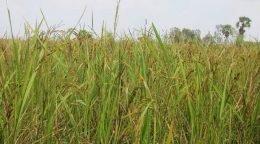
Rice is the main diet for most Cambodian people. Every day, three times a day, Cambodians eat rice. Rice is eaten during breakfast, lunch, and dinner. In the Cambodian culture, rice is used in processing food and beverages such as rice cakes, rice noodles, cooked rice (boiled, fried, steamed), rice soup, rice porridge, sticky rice and, rice wine.
Rice is categorized into three varieties: early rice variety, medium rice variety, and late rice variety. Many types of rice come with different colors including white, black, brown, and red. Rice is grown everywhere in Cambodia by smallholder farmers. However, the lack of a water source or irrigation system has limited many farmers to grow only one cropping per year.
Cambodian agriculture is still unproductive compared to its neighboring countries in the region and the yield is only between 2 – 4 tons per hectare for rice production. According to CFAP’s study, one hectare of rice production costs about USD 405.00 to USD 500 on average.
CFAP made a visit to its member farmers’ organizations in Prey Veng province, namely the Agricultural Development Cooperatives of Mongkul Mean Chey (ADCM), Phum Yoeung Agricultural Development Cooperative (PYADC), Thkov Agricultural Cooperatives (TKAC) and Rithy Ta Aung Agricultural Cooperatives (RTAAC) included Phum Kantrean Agricultural Development Community (PKADC) to know more about their situation.
Rice price during harvest season is around KHR 700-900 per kilogram or USD 0.175 – 0.225 per kilogram. Smallholder farmers in Cambodia normally make KHR 1,400,000 to KHR 3,600,000.00 or USD 350 to USD 900 per hectare from rice production per cropping season. Rice seed, however, has higher prices compared to feeding rice. Fragrant rice seed costs about KHR 2500 per kilogram.
The majority of smallholder farmers still employ traditional farming techniques even though there is new technology provided by farmers’ organizations, development agencies such as the United Nations, and the government. Farmers seem reluctant to apply new practices as it is too new and they seem complicated to employ.
Moreover, the price is sometimes not balanced between the cost of production and income. the cost of agricultural machineries such as tractor, and harvester has increased in recent years so farmers prefer animals instead.
In addition, smallholder farmers have limited knowledge of rice processing, packaging, and transportation. Therefore, losses in post-harvest is also a concern. There is also a limited capacity of farmers’ organizations to access warehouses and rice mills for rice storage and marketing. Thus, many farmers’ organizations in Cambodia still depend much on external support.
To achieve agricultural sustainability, smallholder farmers specialize in agriculture, product processing, and economic initiatives within the community. Farmers must not only be producers, but also suppliers and traders. Moreover, farmers’ organizations specialize in service delivery to farmer members and they should make sure that farmers’ organizations get access to water, soil testing, technology, finance, market, and government policy to support agriculture and farmers. # (CFAP)

Comments are closed